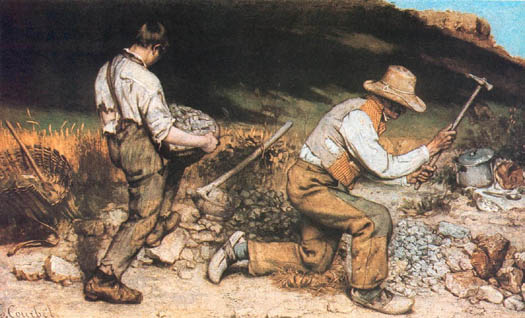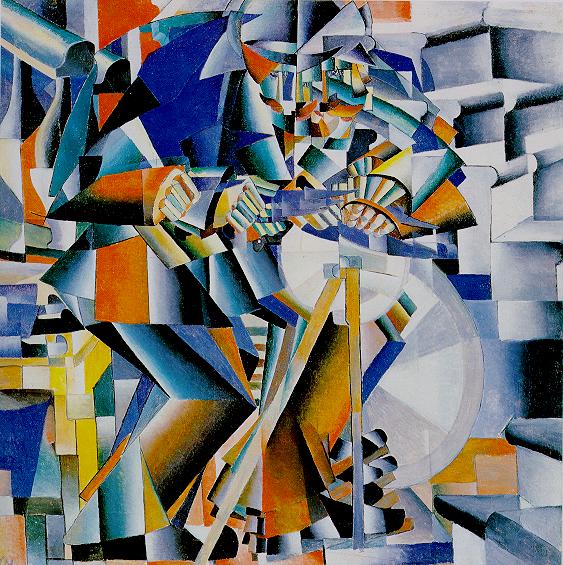Guest Entry by Edward Spencer
Many people have posed the age old question: “what is the opposite of an art historian?” Well, one of the clear frontrunners would have to be a geologist. Therefore, I am shocked to tell you that is what I am (as simplified here by Gustav Courbet, 1849).

When the ‘Stone breakers’ was first displayed in Paris it was reviewed as ‘unartistic, crude, unromantic and socialistic’ – Apparently geologists don’t fit in the art world.
Therefore, although my expertise in art is restricted, this blog entry may bring a fresh guest perspective to the exclusive world of Art History.
As a scientist I have always been drawn to progressive ideas and art and as a result, I have decided to talk about the Futurist movement. This swept Europe at the start of the 20th Century under the lead of Italian artist Filippo Marnetti (1876-1944). His manifesto, published in 1909, was similar to other idiotic ideals of the time and included the aim to “glorify war…the only cure for the world” with a side-order of “scorn for women”. Messages that were then painted in black and white for all to see:
Although an apparent sexist proto-Fascist, Marinetti did get the ball rolling for some great art. In Italy innovative designs for future buildings and machines replaced nudes, soldiers and peacocks that had been the focus of many previous paintings. One of my favourites is this striking design for a modern car by Luigi Rossolo, which powers through the air sending back shockwaves of vivid red:
Rossolo didn’t stop there. He also helped develop Futurist sound and consequently was one of the first ever artists to ‘fire the bass canon’:
Although Futurism was essentially a short-lived Italian art movement (1909-1914), its ideas spread across Europe. In Britain, for instance, Sir Jacob Epstein displayed that he was clearly ahead of the game with his futuristic thinking. One design (pictured below) still clearly inspires modern day science-fiction although it was created a century ago!

Left: Torso in Metal from ‘The Rock Drill’ (1913-14) – THIS WAS SCULPTED A CENTURY AGO!!!
Right: Battle Droid from Star wars Phantom Menace (1999) – SOMEHOW FAILED TO KILL JAR JAR BINKS!!!
Futurism also began to merge with other popular art movements of the time. In Russia, Kazimir Malevich (1879-1935) combined Futurism with French Cubism (Picasso and Braque) to great effect.

Have you guessed what it shows yet? Does it help If I tell you that it is titled “The Knife-grinder” (1912)?
I have to admit that this picture is actually one of my favourites and I’d like to tell you why:
1) Coming from a scientific background and as an avid fan of Countdown (or Wheel of Fortune for our N. American readers) I am partial to a good puzzle. The fragmented forms and contrasting colours grab your attention at first and then you suddenly realise what the subject matter is, giving way to a sense of smugness.
2) Unlike most pictures this gem is awash with motion, catching the essence of Futurism. You can see the knife-grinder’s pedalling feed, the wheel spinning and his arms forcing the knife downwards as he hunches over it. This motion adds an extra dimension to the painting.
3) The subject matter is not that exciting…. It takes a lot of skill to make a grumpy Russian with a knife interesting (unless he is confronting you). Malevich definitely achieves this.
4) This painting will look great in a trendy apartment… I’m not sure what this means in an art historical sense, but to me it means that it is standing the test of time.
Although born out of funny ideas in a torrid time, I think that Futurism displays an originality, boldness and dynamism that still endears today. All of these traits are recognisable and accessible to anyone without prior art historical knowledge (remember, I spend most of my time looking at rocks). So since I’ve just confronted the strange world of art history, I challenge all you art-lovers: What’s your favourite rock and why?




Very enjoyable and informative